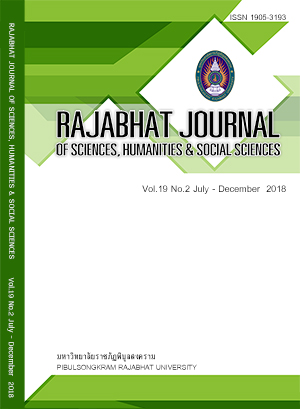UTILIZATION OF BRIQUETTES CHARCOAL FROM PINEAPPLE PEEL
Keywords:
briquetted charcoal, pineapple peel, fuelAbstract
This study aimed to produce charcoal briquettes from pineapple’s peels wastes in processing procedure. The samples were mixed with wet dough glue at 4 different ratios of 80:20, 70:30, 60:40 and 50:50. The cylindrical shape formed had 4 cm diameter with hollow holes whose diameter was 1 cm and length was 10 cm. Fuel properties were tested according to ASTM standard and Thai community product standard. The test results indicated that the samples of all ratios had similar heat values, which were between 5,051.51-5,240.95 calories per gram and higher heat value than Thai community product standard stating that the heat of charcoal briquettes must be at least 5,000 calories per gram and low moisture content. The optimal ratio was 80:20, with a heat value of 5,241.95 calories per gram, moisture content of 5.02%, and ash content of 6.19%. The findings could be used as the guidelines to utilize pineapple wastes to produce charcoal briquettes as an alternative to wood charcoal.
References
Demirbas A. Sustainable Charcoal Production and Charcoal Briquetting. Energy Sources, Part A: Recovery, Utilization, and Environmental Effects. 2009; 31: 1694-1699.
Mopoung S, Udeye V. Characterization and Evaluation of Charcoal Briquettes Using Banana Peel and Banana Bunch Waste for Household Heating. American Journal of Engineering and Applied Sciences. 2017; 10(2): 353-365.
Office of Agricultural Economics. Agricultural Statistics of Thailand year 2007-2016.2016.Available at:
https://www.oae.go.th/download/download_journal/2560/yearbook59.pdf. Accessed October 2, 2016.
Phutteesakul R. The Production of Charcoal Briquette by Coconut Shell and Cassava Rhizome. Master of Education (Industrial Education), Graduate School, Srinakharinwirot University. 2010.
Pochan S. Utilization of pineapple a beef cattle – cows. 2009. Available at: https://expert.dld.go.th/ attachments/article/166/pine_ap.pdf. Accessed October 2, 2016.
Poonkasemm T. A Study of Fuel Briquette from Durian Peel Substitute for Firewood and Charcoal in Household Uses. Master of Science (Appropriate Technology for Resources). Graduate School, Mahidol University, 1999.
Reuben Shuma, Daniel M. Madyira. Production of Loose Biomass Briquettes from Agricultural and Forestry Residues. Procedia Manufacturing. 2017; 7: 98-105.
Tangmankongworakoon A, Preedasuriyachai P. A Study on how to Utilize Coffee Residue and Tea Residue for the Production of Briquettes. Srinakharinwirot University, Journal of Science and Technology. 2015; 7(13): 15-26.
Tantisattayakul T, Saidam K, Phusongsri S.et al. Feasibility Study of Biomass Briquettes Production from Pineapple Peel. Thammasat University, Thai science and technology journal. 2015; 23(5): 754-773.
Ussawarujikulchai A, Semsayun C, Prapakdee N. et al. Utilization of Durian and Mangosteen Peels as Briquette Fuel. Kasetsart University Conference. 2011; 162-168.
Uttamaprakrom W, Vitidsant T. Production of briquette charcoals from wet cake waste of ethanol industry. Engineering journal. 2012; 16(2): 5-17.
Wattanachira L, Laapan N, Chatchavarn V. et al. Development of Biobriquettes from mixed rice-straw and longan waste residues. KMUTT Research and Development Journal. 2016; 39(2): 239-255.
Downloads
Published
How to Cite
Issue
Section
License
Each article is copyrighted © by its author(s) and is published under license from the author(s).









